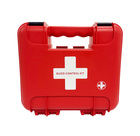Dealing with amputations
Unlock This Video Now for FREE
This video is normally available to paying customers.
You may unlock this video for FREE. Enter your email address for instant access AND to receive ongoing updates and special discounts related to this topic.
Managing Amputated Limbs: Immediate First Aid and Reattachment Tips
Amputated limbs are rare occurrences, but knowing how to handle such emergencies effectively is crucial. The primary focus in managing an amputation is to control the blood flow to prevent significant blood loss.
Initial Response and Bleeding Control
When dealing with an amputation, conduct a primary survey within 90 seconds to identify and address life-threatening issues. Immediate control of arterial bleeds is critical, as they can lead to rapid and severe blood loss.
To control bleeding:
- Apply Pressure: Directly apply pressure over the wound to control bleeding.
- Use Larger Dressings: For severe arterial bleeds, use larger, thicker trauma dressings designed to manage heavy bleeding more effectively than standard ambulance dressings.
- Consider a Tourniquet: In cases of severe arterial bleeding, a tourniquet may be necessary to control blood loss effectively.
Handling the Amputated Limb
Once bleeding is controlled, proper handling of the amputated limb is essential for potential reattachment. Follow these steps:
- Wrap the Limb: First, wrap the amputated limb in cling film to protect against infection and keep it clean.
- Additional Protection: Next, wrap the cling film-covered limb in towels or thin blankets for added protection.
- Cooling: Place the wrapped limb in cold, icy water. Avoid direct contact with ice, as it can damage the nerves and tissues, reducing the chances of successful reattachment.
Transport to Medical Facility
Both the patient and the amputated limb must be transported quickly to an appropriate hospital. Prompt and effective medical intervention is crucial for the best possible outcome.
Conclusion
By following these guidelines for managing amputated limbs, you can provide effective first aid and improve the chances of successful reattachment. Quick action and proper handling are key to achieving the best results in such emergencies.



_-Trauma_8x100_CE.jpg)



_-Trauma_10x10_CE.jpg)